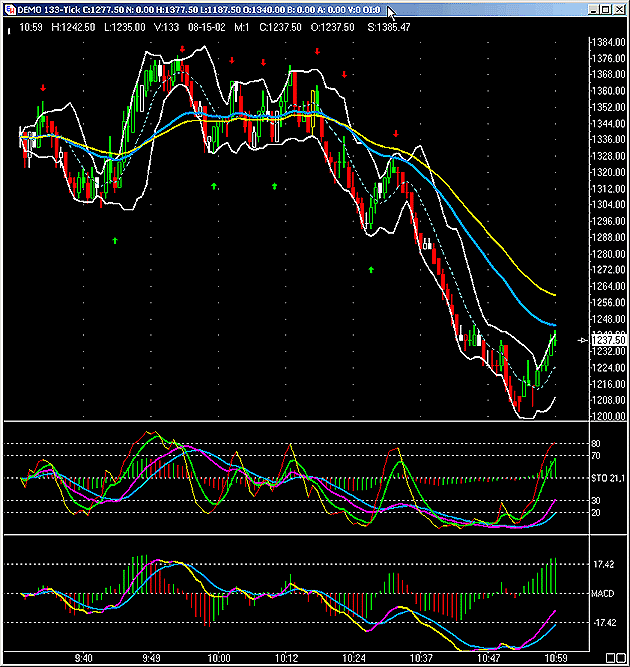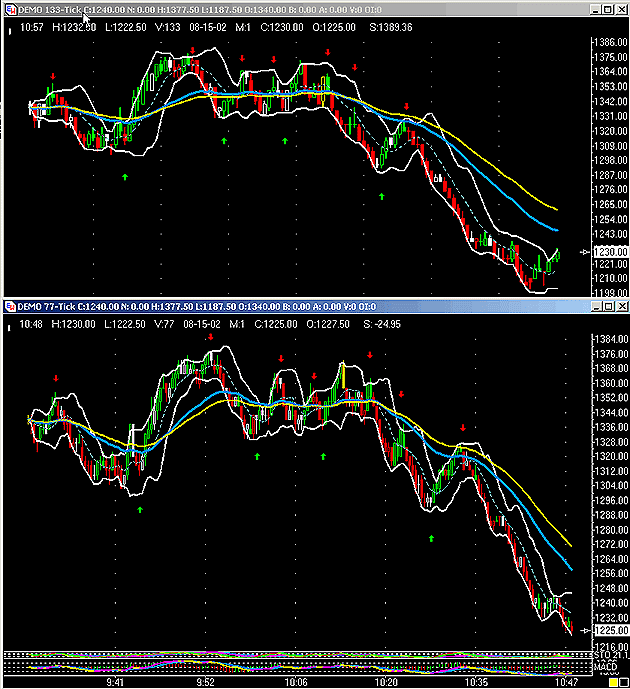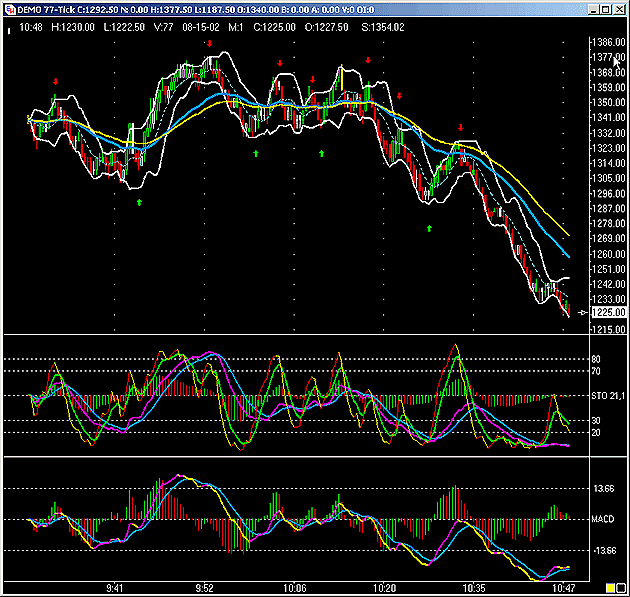Jimmer's
Band Entries
Parameters:
Stochastics: 7, 3, 3 and 21, 10, 4
MACD: 7, 28, 7
Bollinger Bands: 8, 1.8
EMA: 8, 21, 34
Ensign color bands: the lower band in
the price panel is MACD cross
Price bar candles: colored with
Dunnigan colors
I think I
may have reached another stage in my
evolution here. I'm real excited about it
and it I think it's worth talking about. I'm
going to type in 11 trades. Three of them
we'll talk about and the rest of them we'll
just generalize about.

Chart 1 - Click image
to view full size
Trades - times are Pacific: 635S 646L
656S 700L 704S 710S 711L 719S 723S 727L 733
S - all taken on 77t - potential 69 points
Those are the times of the trades and
whether they're long or short
All band related trades , all supported by
something else in the higher TF , a
condition of MACD in higher TF
I use the
343 in the early going because of the speed
of the market. And when I say 69 pts. I
don't mean from top tick to bottom tick.
That allows about a pt. off the top and one
off the bottom.
The main
reason I changed and why I'm talking about
Bollinger Bands so much is that BB enables
me to get into the trades sooner and with
less risk and get out earlier or at a point
where I have maximized the trade by using
the bands. I can get into trades I couldn't
get in before and have no more risk and get
out at a point where I maximized the trades
by using the bands.

Chart 2 - Click image
to view full size
The first one that I wanted to talk about
was one which happened at 10:19 est. That
was a touch on the upper band on the 77T. At
the same time we also had a touch of the
upper band on the 133T. At that time it was
beginning to fall. We also had the touch of
the band on the 210- and almost a touch on
the 343T. The entry is as close as you can
get to where that band is. You can't wait
for it to take out the bar. I felt perfectly
secure taking the trade and using a stop
1-1/2 ticks away. I would not take the trade
unless the bands are not point up anywhere
[i.e., I wouldn't get into a short trade
with the bands heading up on any time
frame.]

Chart 3 - Click image
to view full size
Next trade at 10:23 EST. Again, there was
a poke through the upper band on the 77T, no
touching the 133T but bands are heading down
and the color bars show MA's are crossed
downward with the same situation on the 210T
or the 343T.
Now, I
don't want to pretend that I took all these
trades and made 69 pts. I didn't. I'm a long
way from where I need to be in terms of
translating from observation to execution.
The first 90 minutes move very fast. You can
see how crammed together some of those
trades are. They're only 3-4 minutes apart
in some places and that takes some real
discipline to do, but you see what you get.
My goal has been to try to get 15 pts. an hr
out of each day giving myself and hour and
half slack time allowing myself time for
breaks and family disruptions, etc. If just
look at these tick charts and see how much
movement there is, there's got to be a way
to grab that much because there's really
more. Using the bands I think is enhancing
the ability to do that a lot. Using the
bands the way I'm starting to use them now
has increased the trading potential for me
by 20 to 30%. [The average trade is 5 or 6
points.] When things are slow I get 2 or 3
points. Do not try to trade long against the
band when it is pointing down. The main
thing is if you're using the bands the
proper way and trading with the bands and
entering as close as you can get the risk is
almost zilch.
Look at
10:33 EST - about one of the best of the
day. What didn't it have going for it? There
are other trades, too, slingshot,
divergence., etc. If you use the bands for
entry, you are entering early and getting
more out of the trade, thereby buying you
time and less risk. You have time to sit
there and watch what happens without feeling
threatened. If you study these things and
look at the higher TF's, 210 and up, and see
the bands touched [by price] when the bands
headed down, you know you are safe to enter
short at the upper band on the 77t.
A lot of
these trades taken off the bands are
divergence trades, etc. also. You get an
earlier entry trading off the bands compared
to when you'd be entering otherwise. You
have time to sit there and watch what
happens for a longer time and your risk is
not higher at all. It just isn't. If you
study these things and especially if you
look at the higher TF and if you see when
the bands are touched and not headed up or
down you can't find a time when you get
stopped out for 2 or 3 pts. It just doesn't
happen or very rarely happens.
Don't let
me forget about the epiphany regarding SMAX
because I do want to touch on that, too.
Well, I
talked about how rigid discipline has to be
to trade like this in the early hour and a
half. It gets easier. The opportunities
don't go away; they pop up all the time. The
action turns out to be the same usually. If
it's not to your taste to trade like this
all the time, it's okay, but it can add up
to quite a lot. Some say if you are going to
give yourself a 2 pt. stop, why bother to
take a trade that might be only 2 pts. For
2-3 pt. trade, someone could say risk reward
is 1-1 , but I think you have about a 4 out
of 5 chance of being successful on the
trade. Another reason is simple: there are a
lot of them. So, the risk/reward isn't just
1 to 1, it's really more like 4 to 1 and
there're simply a lot of them.
I usually
trade SMAX, if I'm trading SMAX, on the
133T. At 2:04 EST on the 133T, the MACD was
about to cross upward, but price was right
up against the BB, so since price was at the
top of the BB, the trade was a no-no. Then
price goes under the rising BB and that is
your opportunity to grab it It is still a
valid SMAX trade. [Wait until price touches
the lower BB and enter the trade there as
long as the trade is still valid.] You see
this kind of thing over and over.
That's
about it. It's a multi-time frame thought
process.
It's
interesting. I got on this kick I guess 2 or
3 days ago and really I got excited. I
thought it was too many things to see. I
started concentrating and put my self in a
mental frame of what am I looking for next.
If I see a touch of the band on the 77, what
do I look for next? You want to have a
complete calm when you enter a trade. This
is just different. It's also
counter-intuitive to some degree. It's also
very effective.
Whenever I
talk about points I mean per contract.
Addendum
The technique of using the bollinger
bands to enter trades is to enter when the
band is touched in a lower time frame when
the direction of the trade is supported by
conditions observed in higher time frames.
Those conditions would typically be the
indications given by macd, stochastic,
direction of moving averages, and the slope
(up/down) of the bb in the same and higher
tf.
The method
of entry should be to enter as near as
possible to the bb, preferably within a
point, so that you will be able to set a
stop just below the bb and be risking no
more than 1 1/2 or 2 points. I do not want
to wait for the first up bar (long trade) to
be taken out before entering. That will
cause you to enter typically 2 points
higher. The person who does that will
usually need to place the stop at the same
place as I do but it will be 2 points
further from his entry point. So, if I risk
2, he is risking 4 or maybe more. If the
trade works I make 2 points more and if it
fails, I lose 2 points less. Since most NQ
trades are 10 points or less, that extra 2
points makes for a very significant
percentage increase in my results.
Having used
the bb in this way for over a year, and
through experimentation, I have found the 8
period bb with 1.8 standard deviation to be
the one that best fits the range and
cyclicality of NQ and ES (less thoroughly
studied). I have learned to trust that when
the conditions noted above occur I can
generally enter at the band with confidence
that my risk is minimal and do not need any
other type of "confirmation".
Examples:
1. If price touches a rising lower bb (long)
or a falling upper bb (short) in the traded
time frame, that is a safe entry point.
2. If price
touches a lateral (flat)bb and is also
touching (or nearly touching) a lateral bb
in a higher time frame, that is safe entry
for trade in opposite direction.
3. If price
touches lateral lower bb (for long) and
lower bb on higher tf is distinctly rising,
that is a safe long entry (reverse for
short).
4. If price
touches lower bb and macd and/or stochastic
on higher tf is showing long, that is safe
long entry.